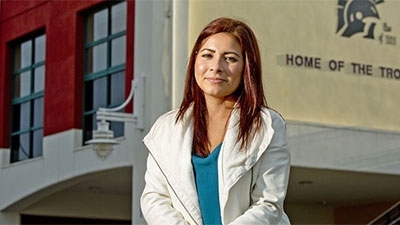The free college movement must not leave adults behind
Nearly two years ago we told you about Damaris Ortiz, who was born in Mexico and immigrated to California in her teens. English wasn’t her first language, but she worked hard and found academic success in high school. Still, she struggled, spending a decade at various institutions while working toward an associate degree. She was 29 and emblematic of today’s student. Damaris knew that pursuing a degree or other credential after high school would be the key to unlocking a good life for herself and her son Ezra, then 1. Damaris, who has since married and moved to Puerto Rico, is now pursuing a bachelor’s degree and plans to attend law school. But her path remains difficult. She and many students like her have obligations that go beyond the classroom, which is why we need to emphasize policies that better meet students’ needs.
Yet many policies ignore the needs of students like Damaris. Take for example the robust national conversation about “free college” (which states often call “promise programs”). Until relatively recently, there has been a distressing lack of focus on adults in these discussions. Many of the free college efforts that have emerged have explicitly been tailored for students coming directly out of the K-12 pipeline, leaving out many low-income adults who, arguably, would benefit most from free pathways and the clear messaging about affordability such pathways imply.
With 35 states having considered 80 bills related to free college over the past three years, the urgency of bringing adults into the fold is clear. So in 2016, Lumina Foundation worked with the State Higher Education Executive Officers association (SHEEO) to come up with a design template to aid states in the development of adult-focused promise programs. Also, the Foundation worked with the Education Commission of the States (ECS) to assess and catalogue efforts that had already been undertaken by states. This work by both SHEEO and ECS was instrumental in accelerating the attention being given to adult students as states pursued their free college plans.
Now, the second phase of this effort has emerged. Over the next several years, Lumina, in partnership with SHEEO, will support the launch of Adult Promise programs in several states. In doing so, we will learn more about effective ways to identify and communicate with these students who are so critical to meeting our national attainment goals. We will assist these states as they explore effective interventions for the financial and non-financial barriers faced by adult students.
Adult students without postsecondary credentials are among those most likely to be struggling in the labor market. They are more likely to have low incomes, and therefore probably eligible for Pell grants. In all but four states, the maximum Pell award is greater than the average tuition and fees at public community colleges. For many adults, tuition and fees at community college already are effectively free—adults just don’t know it because we haven’t told them. Marketing and tailoring promise-type free college programs to this population could be a game-changer.
The inability or perceived inability to pay for education beyond high school is at the heart of concerns about social inequity and income inequality that thread themselves through much of our current national dialogue. It is truly a kitchen table issue. And as students such as Damaris sit at these kitchen tables, planning their futures, we want to ensure we are doing all that we can to help them prepare them to be informed citizens and to succeed in a global economy.
